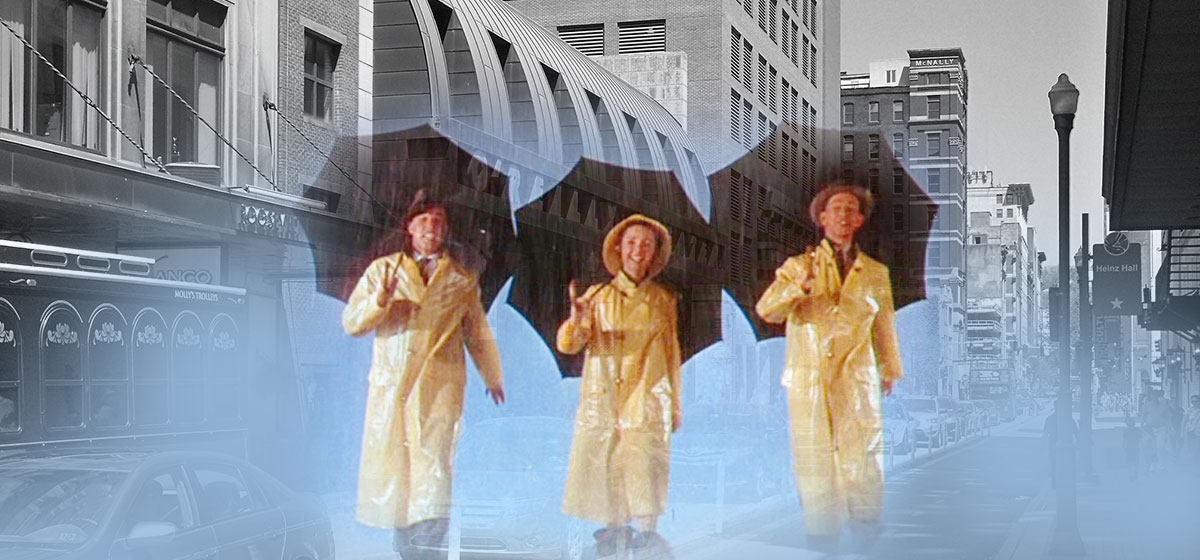Dancing on Pittsburgh Streets: Bring Gene Kelly Alive Again

A shirtless Tupac Shakur stalked the stage at California’s Coachella music festival in 2012. He raised his arms to the roar of the stunned crowd and launched into his posthumous hit single, “Hail Mary.” The performance took place more than 15 years after Shakur was murdered in a drive-by shooting. But on that night at Coachella, he lived on, trading rhymes onstage with Snoop Dogg until his image disintegrated into the night sky.
Tupac’s virtual performance was courtesy of a computer-generated projection, similar to a hologram. An artist can now perform his own tribute.
Christine O’Toole envisions Gene Kelly skating down Penn Avenue in Downtown Pittsburgh maneuvering through theatergoers in a virtual performance from “It’s Always Fair Weather.” Judges liked her idea enough to make her a finalist in the 2019 Pittsburgh Tomorrow Contest, and it was met with approval from Mayor Bill Peduto, Allegheny County Executive Rich Fitzgerald and five foundation leaders.
O’Toole’s idea evolved from recurring discussions in the city about building a statue to honor Gene Kelly. She countered with a virtual dance, feeling that “a monument to a man whose genius was movement should move.”
Large-scale three-dimensional visual projections have been used to have Michael Jackson perform at the 2014 Billboard Music Awards, project Edward Snowden’s head on a statue at Brooklyn’s Fort Green Park and unleash a giant, flaming lion to bound across the roof of a football stadium in Argentina. The technology to project Kelly onto Pittsburgh’s sidewalks is here.
“It’s easy enough to have one person who moves in a fairly confined space on a stage,” O’Toole said. “It’s much more difficult to make it a larger space. I had hoped this could be something that happens outside in Downtown Pittsburgh.”
While it’s tough to pin down a cost for a project of that scale, estimates of the cost of the Tupac performance ranged from $100,000 to $400,000, according to an MTV News article. The Michael Jackson tribute cost “multiple millions,” according to the company that produced the show.
Steve Audia of Carnegie Mellon University’s Entertainment Technology Center said that one of the reasons for the cost is that each still frame of the movie would have to be individually reconstructed, a time-consuming task.
The cost estimates of an outdoor hologram have led O’Toole to also consider a more affordable option using augmented reality technology that makes images materialize on a user’s device, such as a smartphone. New digital platforms, such as Aery, host fine art exhibitions in augmented reality. Artist Richard Humann’s “Ascensions,” a cluster of imaginary constellations in the sky, hang above the High Line in New York City when viewed through the Aery platform on an iPad.
Using similar technology, a user could walk through a real-life environment, such as Penn Avenue in Downtown Pittsburgh, and a digital artwork like a dancing Gene Kelly would skate across the screen of a phone or tablet. As with any projection, there are legal issues to sort out before Kelly can dance again. Licensing rights for the image would need to be secured, for example. The Gene Kelly Image Trust owns the images.
And as it turns out, it’s something Kelly’s widow, Patricia Ward Kelly, has been considering. In an e-mail to O’Toole, she wrote, “We are actually ahead of you on all of this. We have been exploring digital platforms for several years, including Holograms and VR/AR [virtual reality/augmented reality] imaging and are considering several possible installations around the globe.”





